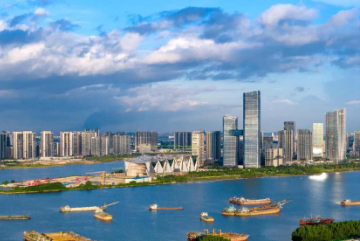By Fu Zimei, Jiang Lin, He Linping, Wang Yunna, People’s Daily
Just how dexterous can a robotic “hand” be?
In a robotics lab in Shenzhen, south China’s Guangdong province, a silver humanoid robot slowly extended its five fingers and delicately picked up a series of fragile items without popping a balloon, crushing a potato chip, or damaging a piece of tofu.
This remarkable dexterity is the product of years of fundamental research originally carried out in Hong Kong, now transformed into real-world applications in Shenzhen, said Duan Jianghua, founder and CEO of Daimon Robotics, a Shenzhen-based tech firm.
With its high level of openness and strong economic vitality, the Shenzhen-Hong Kong-Guangzhou science and technology cluster has ranked second globally for five consecutive years in the Global Innovation Index published by the World Intellectual Property Organization.
In recent years, Guangdong, Hong Kong, and Macao have joined forces to leverage their respective strengths, unleash collaborative synergies, and accelerate the development of a globally influential international innovation and technology hub.
In the increasingly competitive global landscape of science and technology, large-scale and organized research activities are becoming ever more important, with large scientific facilities that focus on cutting-edge exploration and foundational capabilities gaining prominence.
In the Guangdong-Hong Kong-Macao Greater Bay Area (GBA), two innovation corridors, Guangzhou-Shenzhen-Hong Kong and Guangzhou-Zhuhai-Macao, form a sprawling “Y”-shaped network. National-level scientific facilities such as the China Spallation Neutron Source, the Advanced Attosecond Laser Infrastructure, and the Research Facility of Cold-seep Ecosystems stand as critical “pillars” of innovation, while high-level research institutes like Pengcheng Laboratory and Guangzhou Laboratory have been successively established, enabling the region to achieve more breakthroughs from “zero to one.”
At the Institute of Collaborative Innovation of the University of Macau, a human-computer interaction experiment was underway. A participant wearing a headset viewed a sequence of images, with their emotional responses – like or dislike – displayed on the screen in fluctuating shades of green and gray.
The research team was focused on fundamental studies in “affective artificial intelligence.” “Thanks to a dedicated link to the National Supercomputing Center in Guangzhou and the powerful computing capabilities of supercomputer Tianhe-2, we’ve been able to tackle projects that were previously out of reach,” said Xu Chengzhong, interim director of the institute.
Just across a river in Hengqin, the Guangdong Institute of Intelligence Science and Technology has partnered with the University of Macau to establish the Joint Laboratory (Research Center) for Cognition and Brain Sciences.
“By sharing research resources, we are striving to achieve breakthroughs in core technologies,” said Zhang Xu, president of the Guangdong Institute of Intelligence Science and Technology.
Major original innovations in the GBA are the product of collaborative scientific efforts across Guangdong, Hong Kong, and Macao. So far, 34 Guangdong-Hong Kong-Macao joint laboratories have been established and are now in operation.
A series of landmark achievements underscore the area’s growing influence in science and technology: China’s first domestically developed deep-ocean drilling vessel Meng Xiang was officially commissioned in Nansha, Guangzhou; the Hong Kong University of Science and Technology led the development of a multi-functional lunar robot and mobile charging station; and the “Macao Science 1” satellite has orbited the Earth more than 10,000 times, generating a trove of high-precision scientific data. These breakthroughs are steadily pushing the GBA to new heights in technological innovation.
In the chip industry, one of the sectors where China has faced the toughest external restrictions, RISC-V pioneer Tan Zhangxi made a bold move. 7 years ago, he left California and brought his team to Qianhai, Shenzhen, where they founded RISC-V chip company RiVAI, aiming to develop high-performance server chips.
“The hardest part of chip development isn’t making a chip, but achieving sustainable iteration. The GBA offers an ideal environment for this,” Tan said.
In Hong Kong, RiVAI has established a subsidiary, working closely with research institutions, attracting talent, and engaging in international exchanges. “Guangdong has a robust electronics industry with many well-known end-user clients. Its integrated supply chains create a fast-paced ecosystem for technological iteration,” Tan explained.
“Innovation labs are connected to production lines” – this close integration between the innovation and industrial chains – is a key reason why many tech companies are drawn to the GBA.
Hong Kong and Macao offer advantages in international connectivity, global talent recruitment, funding access, and fundamental research. Meanwhile, the Chinese mainland provides complete industrial and supply chains, diverse application scenarios, and a concentration of skilled professionals – conditions that rapidly accelerate the transition from “1 to 100” in product development.
Spanning 56,000 square kilometers, this dynamic region not only supports faster innovation but also offers enterprises broad development opportunities.
Across the GBA, high-tech enterprises in fields like artificial intelligence, robotics, big data, low-altitude economy, autonomous driving, and biomedicine are a common sight. Home to 77,000 national-level high-tech enterprises, the region continues to unleash new drivers of high-quality productivity, propelling science and technology forward with ever-accelerating speed.













